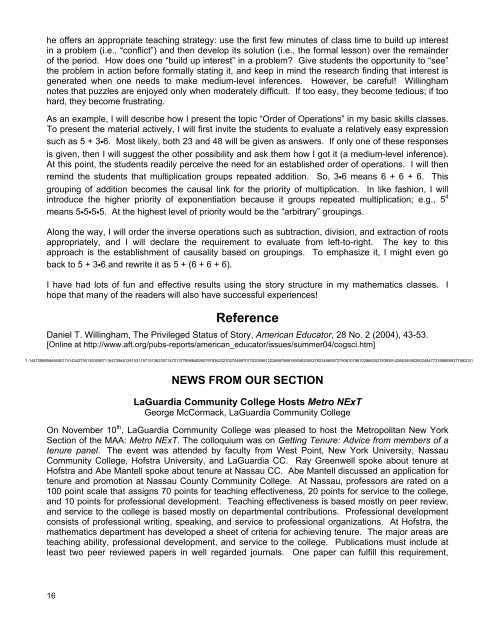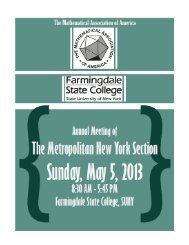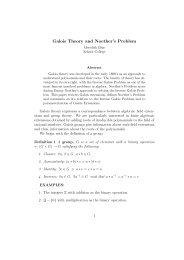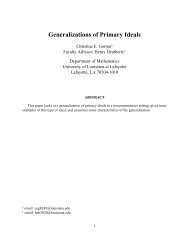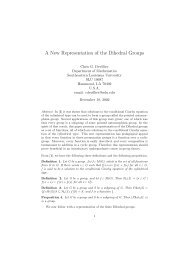2005 Newsletter - MAA Sections - Mathematical Association of ...
2005 Newsletter - MAA Sections - Mathematical Association of ...
2005 Newsletter - MAA Sections - Mathematical Association of ...
You also want an ePaper? Increase the reach of your titles
YUMPU automatically turns print PDFs into web optimized ePapers that Google loves.
he <strong>of</strong>fers an appropriate teaching strategy: use the first few minutes <strong>of</strong> class time to build up interest<br />
in a problem (i.e., “conflict”) and then develop its solution (i.e., the formal lesson) over the remainder<br />
<strong>of</strong> the period. How does one “build up interest” in a problem Give students the opportunity to “see”<br />
the problem in action before formally stating it, and keep in mind the research finding that interest is<br />
generated when one needs to make medium-level inferences. However, be careful! Willingham<br />
notes that puzzles are enjoyed only when moderately difficult. If too easy, they become tedious; if too<br />
hard, they become frustrating.<br />
As an example, I will describe how I present the topic “Order <strong>of</strong> Operations” in my basic skills classes.<br />
To present the material actively, I will first invite the students to evaluate a relatively easy expression<br />
such as 5 + 3i6. Most likely, both 23 and 48 will be given as answers. If only one <strong>of</strong> these responses<br />
is given, then I will suggest the other possibility and ask them how I got it (a medium-level inference).<br />
At this point, the students readily perceive the need for an established order <strong>of</strong> operations. I will then<br />
remind the students that multiplication groups repeated addition. So, 3i6 means 6 + 6 + 6. This<br />
grouping <strong>of</strong> addition becomes the causal link for the priority <strong>of</strong> multiplication. In like fashion, I will<br />
introduce the higher priority <strong>of</strong> exponentiation because it groups repeated multiplication; e.g., 5 4<br />
means 5i5i5i5. At the highest level <strong>of</strong> priority would be the “arbitrary” groupings.<br />
Along the way, I will order the inverse operations such as subtraction, division, and extraction <strong>of</strong> roots<br />
appropriately, and I will declare the requirement to evaluate from left-to-right. The key to this<br />
approach is the establishment <strong>of</strong> causality based on groupings. To emphasize it, I might even go<br />
back to 5 + 3i6 and rewrite it as 5 + (6 + 6 + 6).<br />
I have had lots <strong>of</strong> fun and effective results using the story structure in my mathematics classes. I<br />
hope that many <strong>of</strong> the readers will also have successful experiences!<br />
Reference<br />
Daniel T. Willingham, The Privileged Status <strong>of</strong> Story, American Educator, 28 No. 2 (2004), 43-53.<br />
[Online at http://www.aft.org/pubs-reports/american_educator/issues/summer04/cogsci.htm]<br />
1.1447298858494001741434273513530587116472948129153115715136230714721377698848260797836232702754897077020098122286979891590482055279234565872790810788102868252763939142663459029024847733588699377892031<br />
NEWS FROM OUR SECTION<br />
LaGuardia Community College Hosts Metro NExT<br />
George McCormack, LaGuardia Community College<br />
On November 10 th , LaGuardia Community College was pleased to host the Metropolitan New York<br />
Section <strong>of</strong> the <strong>MAA</strong>: Metro NExT. The colloquium was on Getting Tenure: Advice from members <strong>of</strong> a<br />
tenure panel. The event was attended by faculty from West Point, New York University, Nassau<br />
Community College, H<strong>of</strong>stra University, and LaGuardia CC. Ray Greenwell spoke about tenure at<br />
H<strong>of</strong>stra and Abe Mantell spoke about tenure at Nassau CC. Abe Mantell discussed an application for<br />
tenure and promotion at Nassau County Community College. At Nassau, pr<strong>of</strong>essors are rated on a<br />
100 point scale that assigns 70 points for teaching effectiveness, 20 points for service to the college,<br />
and 10 points for pr<strong>of</strong>essional development. Teaching effectiveness is based mostly on peer review,<br />
and service to the college is based mostly on departmental contributions. Pr<strong>of</strong>essional development<br />
consists <strong>of</strong> pr<strong>of</strong>essional writing, speaking, and service to pr<strong>of</strong>essional organizations. At H<strong>of</strong>stra, the<br />
mathematics department has developed a sheet <strong>of</strong> criteria for achieving tenure. The major areas are<br />
teaching ability, pr<strong>of</strong>essional development, and service to the college. Publications must include at<br />
least two peer reviewed papers in well regarded journals. One paper can fulfill this requirement,<br />
16


